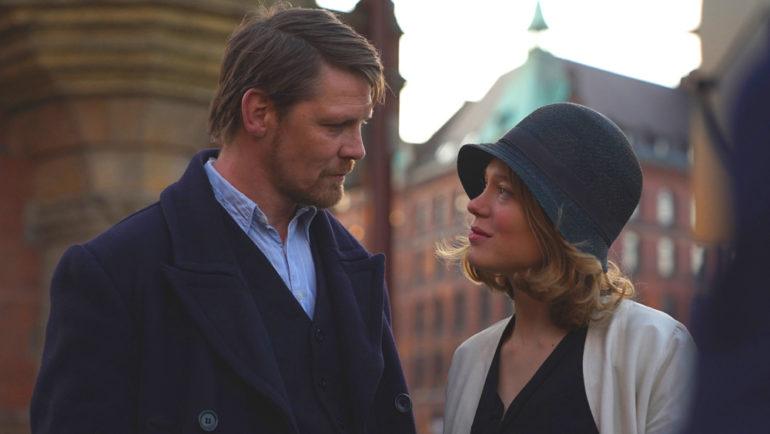First Look: Léa Seydoux in ‘The Story of My Wife’ From Ildikó Enyedi (EXCLUSIVE)
By Leo Barraclough
LOS ANGELES (Variety.com) – Variety has been given the first-look image from Oscar-nominated director Ildikó Enyedi’s “The Story of My Wife,” starring Palme d’Or winner Léa Seydoux. We spoke to Enyedi about the film, which is being sold at Cannes by Films Boutique.
Enyedi’s “On Body and Soul” won the Golden Bear at Berlin in 2017 and was Oscar nominated the following year. Seydoux won Cannes’ Palme d’Or, alongside director Abdellatif Kechiche and co-star Adèle Exarchopoulos for “Blue Is the Warmest Color” in 2013.
“The Story of My Wife,” budgeted at Euros 10 million ($11.2 million), is an adaptation of Milan Fust’s 1942 novel of the same name. The story, a variation of the legend of the Flying Dutchman, is set in the 1920s. In it sea captain Jakob Storr makes a bet in a cafe with a friend that he will marry the first woman who enters the place, and then in walks Lizzy. Fust’s novel was first published in Hungary in 1942, but only translated into English in the late 1980s, when it became a literary sensation.
The project, Enyedi’s first English-language feature, re-teams the director with her “On Body and Soul” producers Monika Mecs, Andras Muhi and Erno Mesterhazy of Hungary’s Inforg-M&M Film. Berlin-based Komplizen Film, the producer of Oscar-nominated “Toni Erdmann,” is on board as co-producer, alongside France’s Pyramide Productions and Italy’s Dorje Film.
The first phase of principal photography finished in Hamburg recently. Further shooting locations include Budapest and Malta. The film is supported by the Hungarian National Film Fund, Eurimages and Arte.
Agnes Havas, CEO of the Hungarian National Film Fund, said: “I’m delighted that a pearl of Hungarian literature, Milan Fust’s enigmatic novel ‘The Story of My Wife’ will be adapted for the big screen in European co-production, majority supported by Hungary’s Film Fund. The novel has been translated into more than 20 languages, published all around the world and available in online bookstores. I can’t wait to see the English-language film version starring world cinema’s finest talents.”
Also in the cast are Gijs Naber (“How to Avoid Everything”), Louis Garrel (“Redoubtable”), Josef Hader (“Stefan Zweig: Farewell to Europe”), Sergio Rubini (“The Stuff of Dreams”) and Jasmine Trinca (“Honey”).
What led you to adapt Milan Fust’s book as your next project?
Ildikó Enyedi: As an only child I was a bookish girl and one of the decisive moments of my teenage years was my meeting with this novel. It speaks with disarming sincerity and sometimes frightening lucidity about our human flaws and, at the same time treats its imperfect, failing heroes with immense tenderness. A rare combination.
What are the challenges of this project?
Ildikó Enyedi: Well, there are invisible, nearly subconscious thematic ghettos for an Eastern European woman director. This film ignores them – not because I intend to ignore anything, but, because I want to follow simply and faithfully the inner needs of this project I love so passionately. I hope the film will be strong and convincing enough to make everyone forget these hidden expectations and audiences let themselves be lost in it.
Why did you decide to shoot it in English?
Ildikó Enyedi: The absolute protagonist of this film is Jakob, a Dutch freighter sea captain in the 1920s (the book is based on the myth of the Flying Dutchman) played by Gijs Naber, a fine, highly talented Dutch actor with an amazing presence. A real discovery! In the shipping trade – Jakob’s profession – English was used (as Latin for doctors or French for diplomats in those years). English is also their only common language with Lizzy, his French wife played by Léa Seydoux. Although the dialogues are mostly in English, French, German and Italian appear in the film as well: everyone speaks the language that is natural and credible in the given situation.
Why were Léa Seydoux and Louis Garrel best suited for the lead roles, alongside Gijs Naber?
Ildikó Enyedi: I admire Léa’s boldness, her urge to risk herself again and again for creating something alive and true. Like an acrobat on the trapeze. As the power of this film depends on the power of this enigmatic central personality, Lizzy, who sets all sorts of events in motion without ever really moving, I needed an actress with a very strong charisma. I am happy to have found also a female ally with whom we can work on the basis of deep mutual trust. Louis Garrel – the third member of this love-triangle – is the most dangerous sort of counterpart for Jakob: he has all the charm, the eloquence and the sophisticated humor that Jakob, who spends his life at sea, is missing.
What are the contemporary resonances of the story?
Ildikó Enyedi: This film is a love letter to all the wonderfully imperfect men – to the loves of our life, written by a woman director. When I was a kid the male attribute I envied the most was chivalry. I would like to permit myself now to be chivalrous. I would like to add a gentle touch to the general discussion of today about communication between the sexes. I am so glad that through some longtime closed and now opened windows fresh air is pouring in, that our social habits are changing for the better. Let’s do it with more kindness and more humor – it will not be less effective but it will definitely be more fun for all of us.

